![]()

La Bohème (1926)
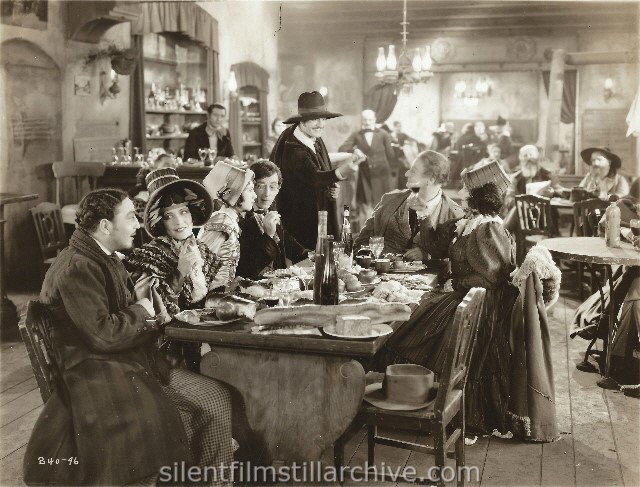
240-96 Renée Adorée (second from left), John Gilbert (standing)

LILLIAN GISH
JOHN GILBERT
in a
KING VIDOR Production
LA BOHEME
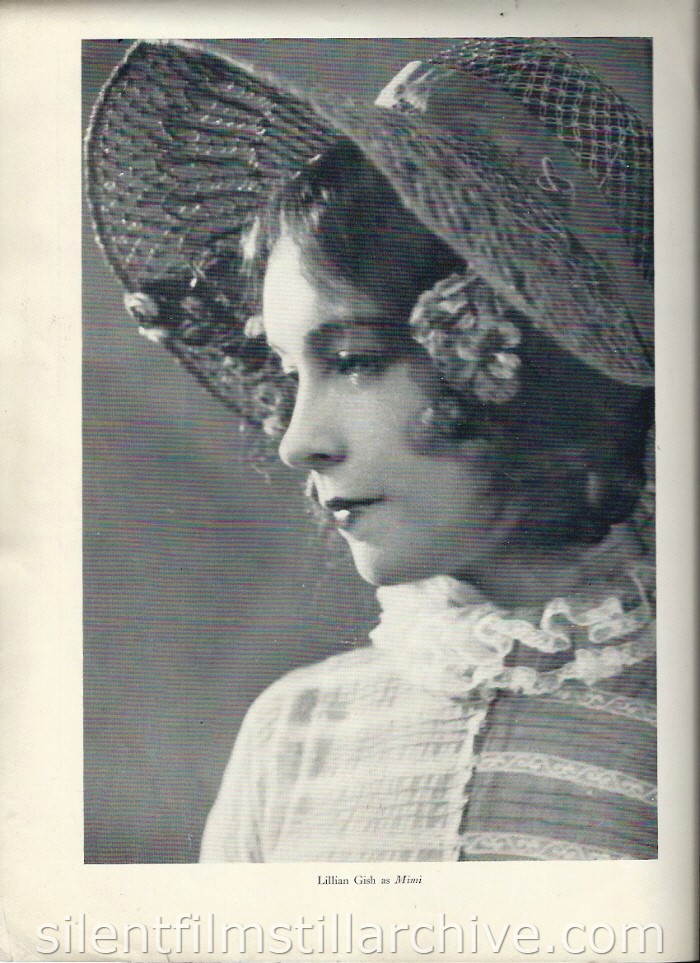
Lillian Gish as Mimi

Metro-Goldwyn-Mayer
presents
LILLIAN GISH
and
JOHN GILBERT
in
KING VIDOR'S
production
LA BOHEME
with
RENEE ADOREE, GEORGE HASSELL, ROY D'ARCY, KARL
DANE, FRANK CURRIER AND EDWARD EVERETT HORTON
By FRED DE GRESAC
Suggested by Henry Murger's
"LIFE IN THE LATIN
QUARTER"
Continuity by
RAY DOYLE and HARRY BEHN
Directed by
KING VIDOR
A METRO-GOLDWYN-MAYER PICTURE
Presentation and Musical
Score Arranged by
Major Edward Bowers, David Mendoza and William Axt

John Gilbert as Rudolphe
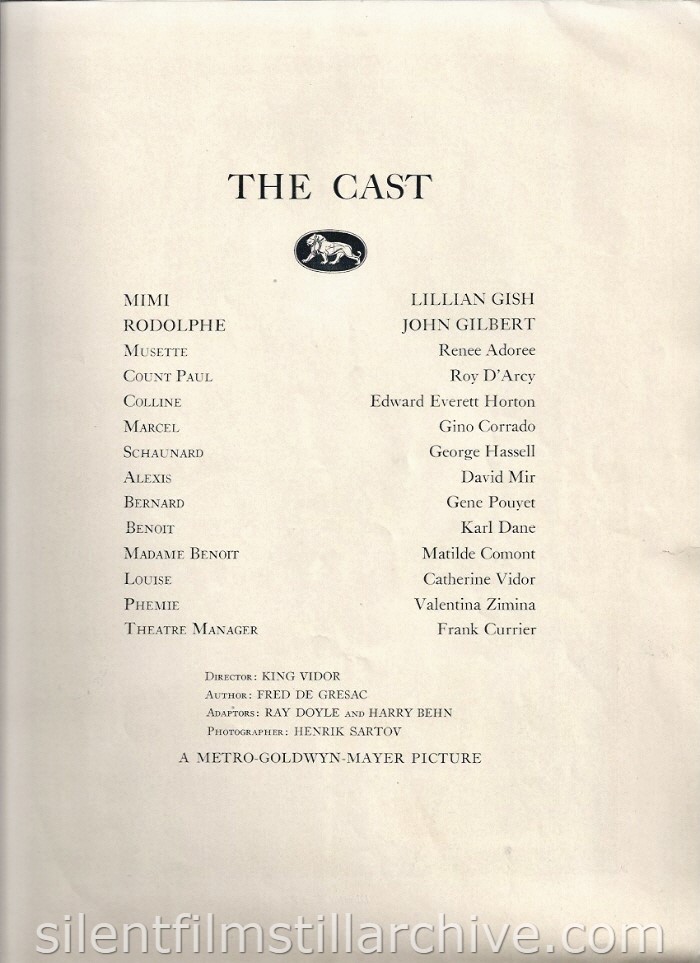
THE CAST
|
MIMI |
LILLIAN GISH |
|
RODOLPHE |
JOHN GILBERT |
|
MUSETTE |
Renee Adoree |
|
COUNT PAUL |
Roy D'Arcy |
|
COLLINE |
Edward Everett Horton |
|
MARCEL |
Gino Corrado |
|
SCHAUNARD |
George Hassell |
|
ALEXIS |
David Mir |
|
BERNARD |
Gene Pouyet |
|
BENOIT |
Karl Dane |
|
MADAME BENOT |
Matilde Comont |
|
LOUISE |
Catherine Vidor |
|
PHEMEIE |
Valentina Zimina |
|
THEATRE MANAGER |
Frank Currier |
Director: KING VIDOR
AUTHOR: FRED DE GRESAC
ADAPTORS:
RAY DOYLE and HARRY BEHN
PHOTOGRAPHER: HENRIK SARTOV
A METRO-GOLDWYN-MAYER PICTURE
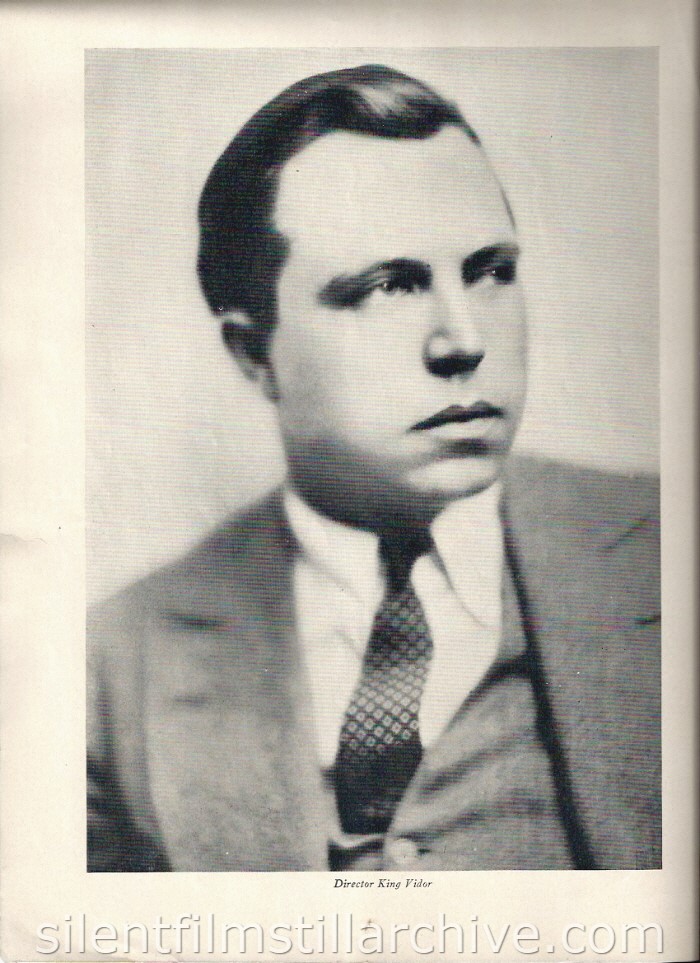
Director King Vidor
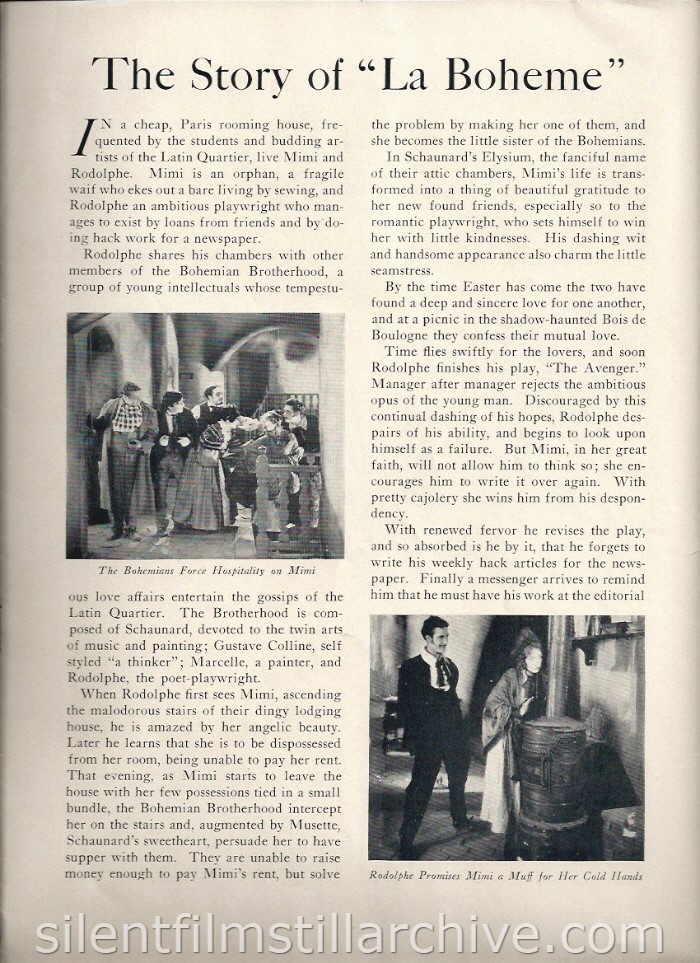
The Story of "La Boheme"
IN a cheap, paris rooming house, frequented by the students and budding artists of the Latin Quartier, live Mimi and Rudolphe. Mimi is an orphan, a fragile waif who ekes out a bare living by sewing, and rodolphe an ambitious playwright who manages to exist by loans from friends and by doing hack work for a newspaper.
Rodolphe shares his chambers with other members of the Bohemian Brotherhood, a group of young intellectuals whose tempestuous love affairs entertain the gossips of the Latin Quartier. The Brotherhood is composed of Schaunard, devoted to the twin arts of music and painting; Gustave Colline, self styled "a thinker"; Marcelle, a painter, and Rodolphe, the poet-playwright.
When Rodolphe first sees Mimi, ascending the malodorous stairs of their dingy lodging house, he is amazed by her angelic beauty. Later he learns that she is to be dispossessed from her room, being unable to pay her rent. That evening, as Mimi starts to leave the house with her few possessions tied in a small bundle, the Bohemian Brotherhood intercept her on the stairs and, augmented by Musette, Schaunard's sweetheart, persuade her to have supper with them. They are unable to raise money enough to pay Mimi's rent, but solve the problem by making her one of them, and she becomes the little sister of the Bohemians.
In Schaunard's Elysium, the fanciful name of their attic chanbers, mimi's life is transformed into a thing of beautiful gratitude to her new found friends, especially so to the romantic playwright, who sets himself to win her with little kindnesses. His dashing wit and handsome appearance also charm the little seamstress.
By the time Easter has come the two have found a deep and sincere love for one another, and at a picnic in the shadow-haunted Bois de Boulogne they confes their mutual love.
Time flies swiftly for the lovers, and soon Rodolphe finishes his play, "The Avenger." Manager after manager rejects the ambitious opus of the young man. Discouraged by this continual dashing of his hopes, Rodolphe despairs of his ability, and begins to look upon himself as a failure. But Mimi, in her great faith, will not allow him to think so; she encourages him to writ it over again. With petty cajolery she wins him from his despondency.
With renewed fervor he revises the play, and so absorbed is he by it, that he forgets to write his weekly hack articles for the newspaper. finally a messenger arrives to remind him that he must have his work at the editorial
The Bohemians Force hospitality on Mimi
Rodolphe Promises Mimi a Muff for Her Cold Hands
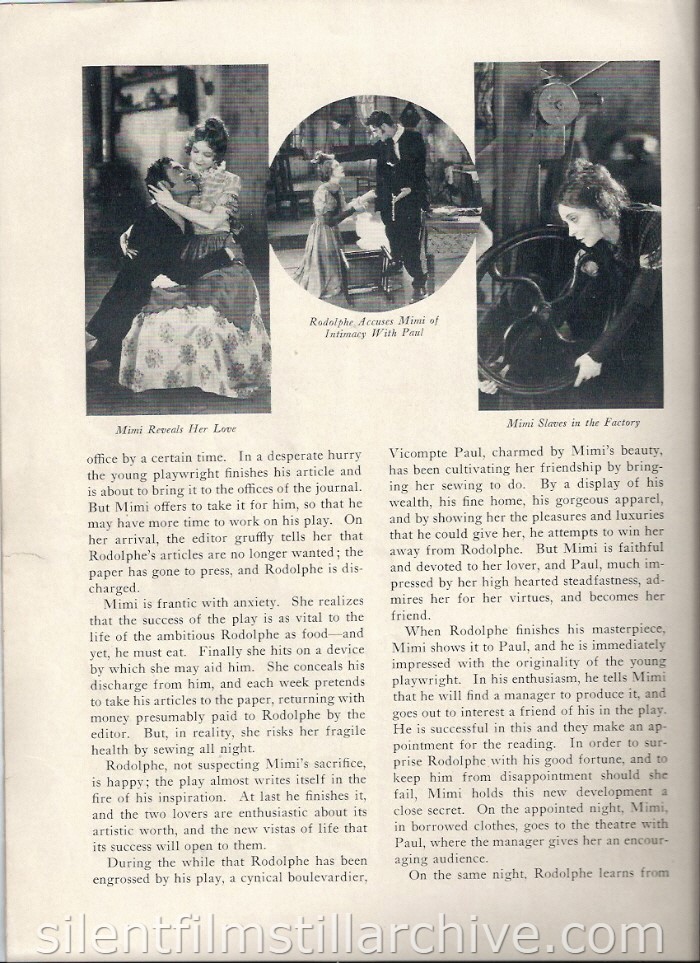
Mimi Reveals Her Love
Rodolphe Accuses Mimi
of Intimacy with Paul
Mimi Slaves in the Factory
office by a certain time. In a desperate hurry the young playwright finishes his article and is about to bring it to the offices of the journal. but Mimi offers to take it for him, so that he may have more time to work on his play. On her arrival, the editor griffly tells her that Rodolphe's articles are no longer wanted; the paper has gone to press, and Rodolphe is discharged.
Mimi is frantic with anxiety. She realizes that the success of the play is as vital to the life of the ambitious Rodolphe as food -- and yet, he must eat. Finally she hits on a device by which she may aid him. She conceals his discharge from him, and each week pretends to take his articles to the paper, returning with money presumably paid to Rodolphe by the editor. But, in reality, she ricks her fragile health by sewing all night.
Rodolphe, not suspecting Mimi's sacrifice, is happy; the play almost writes itself in the fire of his inspiration. At last he finishes it, and the tow lovers are enthusiastic about its artistic worth, and the new vistas of life that its success will open to them.
During the while that Rudolphe has been engrossed by his play, a cynical boulevardier, Vicompte Paul, charmed by Mimi's beauty, has been cultivating her friendship by bringing her sewing to do. By a disply of his wealth, his fine home, his gorgeous apparel, and by shoing her the pleasures and luxuries that he could give her, he attempts to win her away from rodolphe. But Mimi is faithful and devoted to her lover, and Paul, much impressed by her high hearted steadfastness, admires her for her virtues, and becomes her friend.
When Rodolphe finishes his masterpiece, Mimi shows it to Paul, and he is immediately impressed with the originality of the young playwright. In his enthusiasm, he tells Mimi that he will find a manager to produce it, and goes out to interest a friend of his in the play. He is successful in this and they make an appointment for the reading. In order to surprise Rodolphe with his good fortune, and to keep him from disappointment should she fail, Mimi holds this new development a close secret. On the appointed night, Mimi, in borrowed clothes, goes to the theatre with Paul, where the manager gives her an encouraging audience.
On the same night, Rodolphe learns from
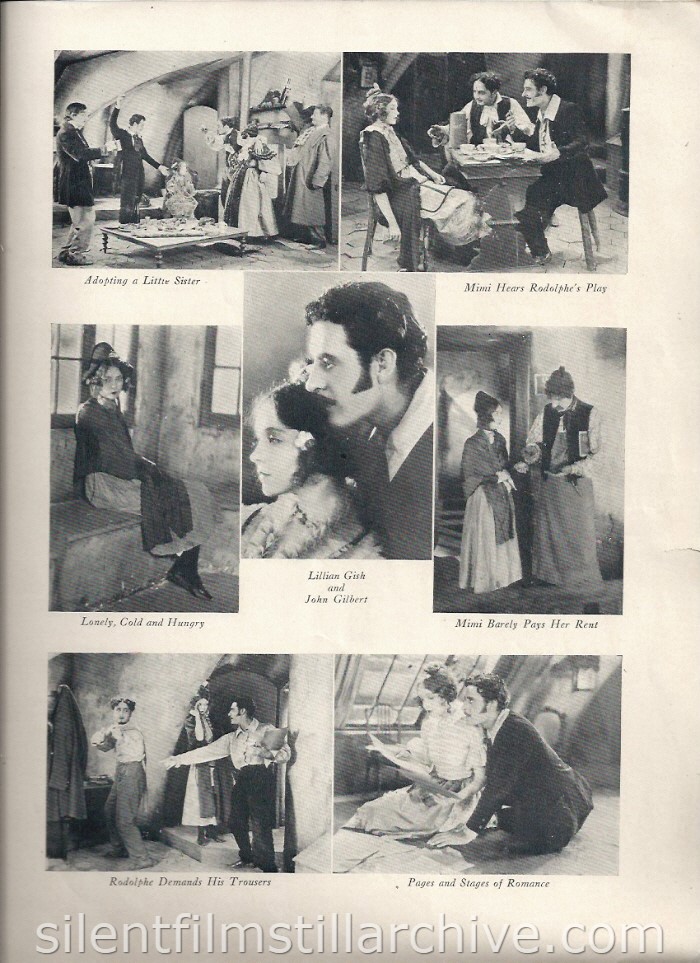
Adopting a Little Sister
Mimi Hears Rodolphe's Play
Lonely, Cold and Hungry
Lillian Gish and John Gilbert
Mimi Barely Pays Rent
Rodolphe Demands his Trousers
Pages and Stages of Romance
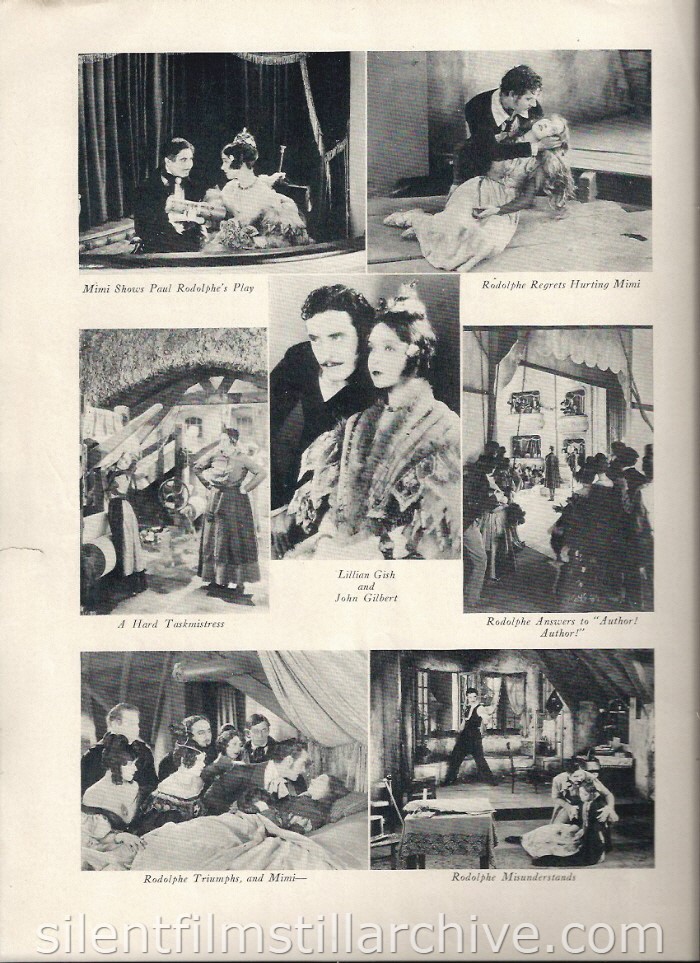
Mimi Shows Paul Rodolphe's Play
Rodolphe
Regrets Hurting Mimi
A Hard Taskmistress
Lillian Gish and John Gilbert
Rodolphe Answers to "Author! Author!"
Rodolphe Triumphs, and Mimi--
Rodolphe Misunderstands
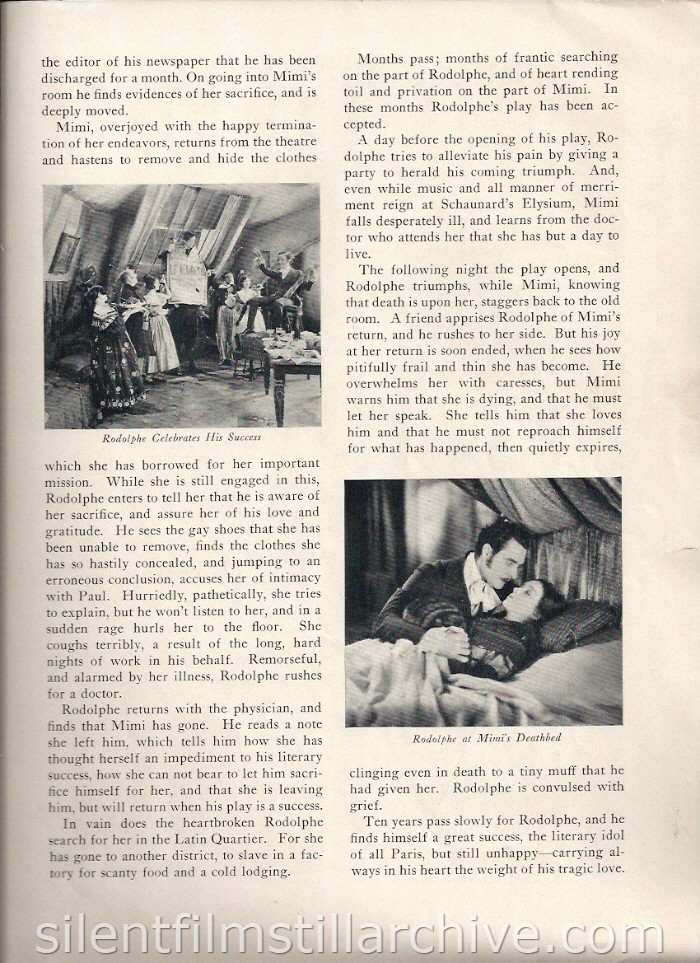
the editor of his newspaper that he has been discharged for a month. On going into Mimi's room he finds evidences of her sacrifice, and is deeply moved.
Mimi, overjoyed with the happy termination of her endeavors, returns from the theatre and hastens to remove and hide the clothes which she has borrowed for her important mission. While she is still engaged in this, Rodolphe enters to tell her that he is aware of her sacrifice, and assure her of his love and gratitude. He sees the gay shoes that she has been unable to remove, finds the clothes she has so hastily concealed, and jumping to an erroneous conclusion, accuses her of intimacy with Paul. Hurriedly, pathetically, she tries to explain, but he won't listen to her, and in a sudden rage hurls her to the floor. She coughs terribly, a result of the long, hard nights of work in his behalf. Remorseful, and alarmed by her illness, rodolphe rushes for a doctor.
Rodolphe returns with the physician, and finds that Mimi has gone. he reads a note she left him, which tells him how she has thought herself an impediment to his literary success, how she can not bear to let him sacrifice himself for her, and that she is leaving him, but will return when his play is a success.
In vain does the heartbroken Rodolphe search for her in the Latin Wuartier. For she has gone to another district, to slave in a factory for scanty food and a cold lodging.
Months pass; months of frantic searching on the part of Rodolphe, and of heart randing toil and privation on the part of Mimi. In these months Rodolphe's play has been accepted.
A day before the opening of his play, Rodolphe tries to alleviate his pain by giving a party to herald his coming triumph. And, even while music and all manner of merriment reign at Schaunard's Elysium, Mimi falls desperately ill, and learns from the doctor who attends her that she has but a day to live.
The following night the play opens, and rodolphe triumphs, while Mimi, knowing that death is upon her, staggers back to the old room. A friend apprises Rodolphe of Mimi's return, and he rushes to her side. But his joy at her return is soon ended, when he sees how pitifully frail and thin she has become. He overwhelms her with caresses, but Mimi warns him that she is dying, and that he must let her speak. She tells him that she loves him and that he must not reproach himself for what has happened, then quietly expires, clinging even in death to a tiny muff that he had given her. Rodolphe is convulsed with grief.
Ten years pass slowly for Rodolphe, and he finds himself a great success, the literary idol of all Paris, but still unhappy -- carrying always in his heart the weight of his tragic love.
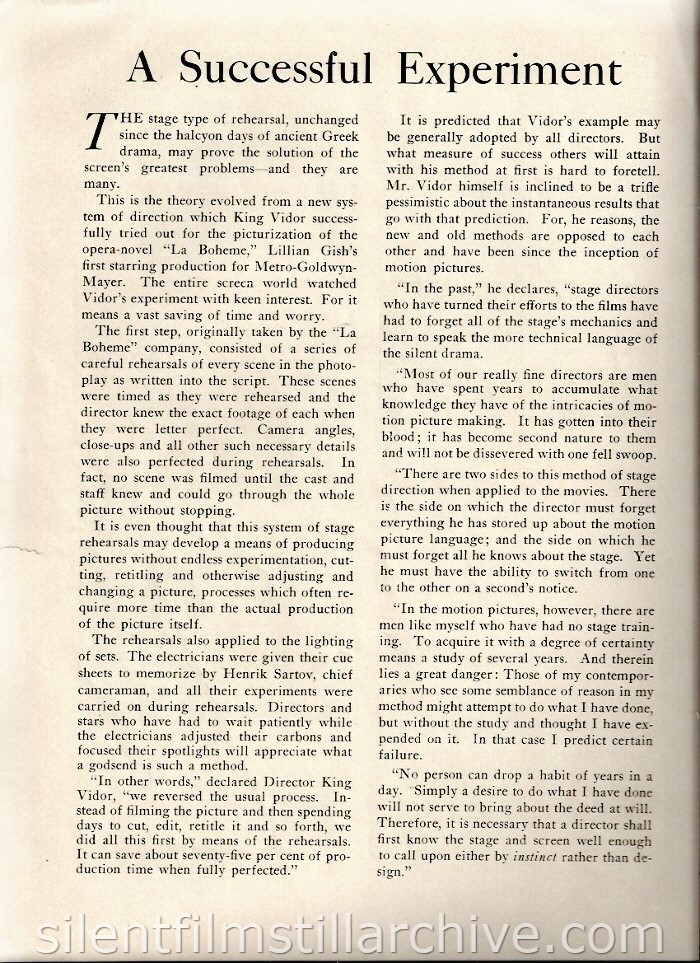
A Successful Experiment
THE stage type of rehearsal, unchanged since the halcyon days of ancient Greek drama, may prove the solution of the screen's greatest problems -- and they are many.
This is the theory evolved from a new system of direction which King Vidor successfully tried out for the picturization of the opera-novel "La Boheme," Lillian Gish's first starring production for Metro-Goldwyn-Mayer. The entire screen world watched Vidor's experiment with keen interest. For it means a vast saving of time and worry.
The first step, originally taken by the "La Boheme" company, consisted of a series of careful rehearsals of every scene in the photoplay as written into the script. These scenes were times as they were rehearsed and the director knew the exact footage of each when they were letter perfect. Camera angles, close-ups and all other such necessary details were also perfected during rehearsals. In face, no scene was filmed until the cast and staff knew and could go through the while picture without stopping.
It is even thought that this system of stage rehearsals may develop a means of producing pictures without endless experimentation, cutting, retitling, and otherwise adjusting and changing a picture, processes which often require more time than the actual production of the picture itself.
The rehearsals also applied to the lighting of sets. The electricians were given their cue sheets to memorize by Henrik Sartov, chief cameraman, and all their experiments were carried on during rehearsals. Directors and stars who have had to wait patiently while the electricians adjusted their carbons and focused their spotlights will appreciate what a godsend is such a method.
"In other words," declared Directory king Vidor, "We reversed the usual process. Instead of filming the picture and then spending days to cut, edit, and retitle it and so forth, we did all this first by means of the rehearsals. it can save about seventy-five percent of production time when fully perfected."
It is predicted that Vidor's example may be generally adopted by all directors. But what measure of success others will attain with his method at first is hard to foretell. Mr. Vidor himself is inclined to be a trifle pessimistic about the instantaneous results that go with that prediction. For, he reasons, the new and old methods are opposed to each other and have been since the inception of motion pictures.
"In the past," he declares, "stage directors who have turned their efforts to the films have had to forget all of the stage's mechanics and learn to speak the more technical language of the silent drama.
"Most of our really fine directors are men who have spent years to accumulate what knowledge they have of the intricacies of motion picture making. It has gotten into their blood; it has become second nature to them and will not be dissevered with one fell swoop.
"There are two sides to this method of stage direction when applied to the movies. There is the side on which the director must forget everything he has store up about the motion picture language; and the side on which he must forget all he knows about the stage. Yet he must have the ability to switch from one to the other on a second's notice.
"In the motion pictures, however, there are men like myself who have had no stage training. To acquire it with a degree of certainty means a study of several years. And therein lies a great danger; Those of my contemporaries who see some semblance of reason in my method might attempt to do what I have done, but without study and thought I have expended on it. In that case I predict certain failure.
"No person can drop a habit of years in a day. Simply a desire to do what I have done will not serve to bring about the deed at will. Therefore, it is necessary that a directory shall first know the stage and screen well enough to call upon either by instinct rather than design."
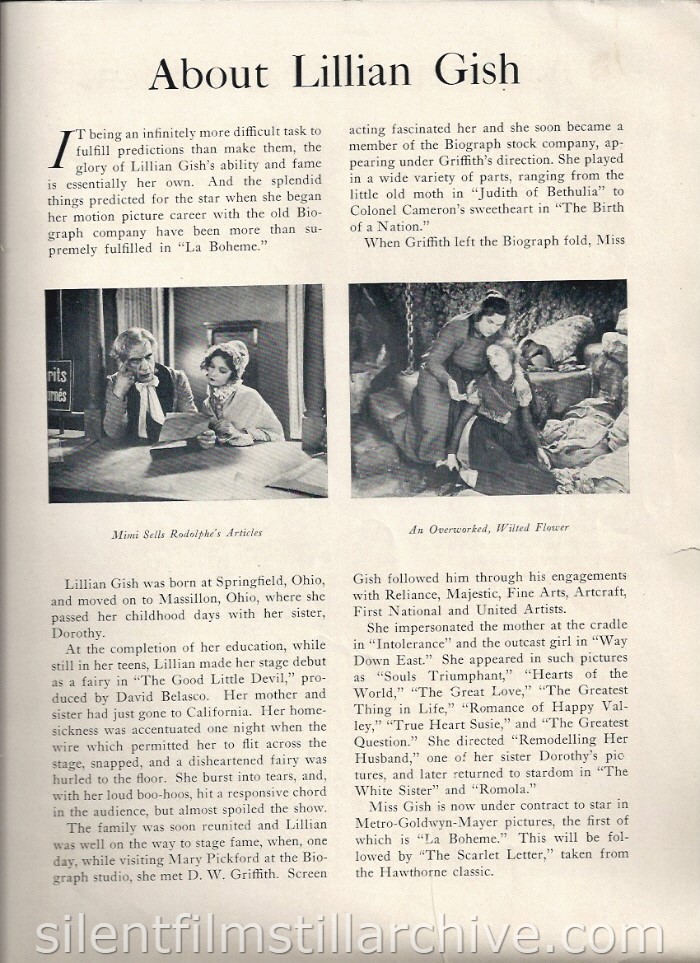
About Lillian Gish
It being an infinitely more difficult task to fulfill predictions than make them, the glory of Lillian gish's ability and fame is essentially her own. And the splendid things predicted for the star when she began her motion picture career with the old Biograph company have been more than supremely fulfilled in "La Boheme."
Mimi Sells Rodolphe's Articles
Lillian gish was born at Springfield, Ohio, and moved on to Massillon, Ohio where she passed her childhood days with her sister, Dorothy.
At the completion of her education, while still in her teens, Lillian made her stage debut as a fairy in "The Good Little Devil," produced by David Belasco. Her mother and sister had just gone to California. Her homesickness was accentuated one night whe the wire which permitted her to flit across the stage, snapped, and a sidheartened fairy was hurled to the floor. She burst into tears, and, with her loud boo-hoos, hit a reponsive chord in the audiencd, but almost spoiled the show.
The family was soon reunited and Lillian was well on the way to stage fame, when, one day, while visiting Mary Pickford at the Biograph studiom she met D. W. Griffith. Screen acting fascinate her and she soon became a member of the Biograph stock company, appearing under Griffith's direction. She played in a wide variety of parts, ranging from the little old moth in "Judith of Bethulia" to colonel Cameron's sweetheart in "The Birth of a Nation."
When Griffith left the Biograph fold, Miss Gish followed him through his engagements with Reliance, majestic, Fine Arts, Artcraft, First National and United Artists.
An Overworked, Wilted Flower
She impersonated the mother at the cradle in "Intolerance" and the outcast girl in "Way Down East." She appeared in such pictures as "Souls Triumphant, "Hearts of the World," "The Great Love," "The Greatest Thing in Live," "Romance of Happy Valley, "True Heart Susie," and "The Greatest Question." She directed "Remodelling Her Husband," one of her sister Dorothy's pictures, and later returned to stardom in "The White Sister" and "Romola."
Miss Gish is now under contract to star in Metro-Goldwyn-Mayer pictures, the first of which is "La Boheme." This will be followed by "The Scarlet Letter," taken from the Hawthorne classic.
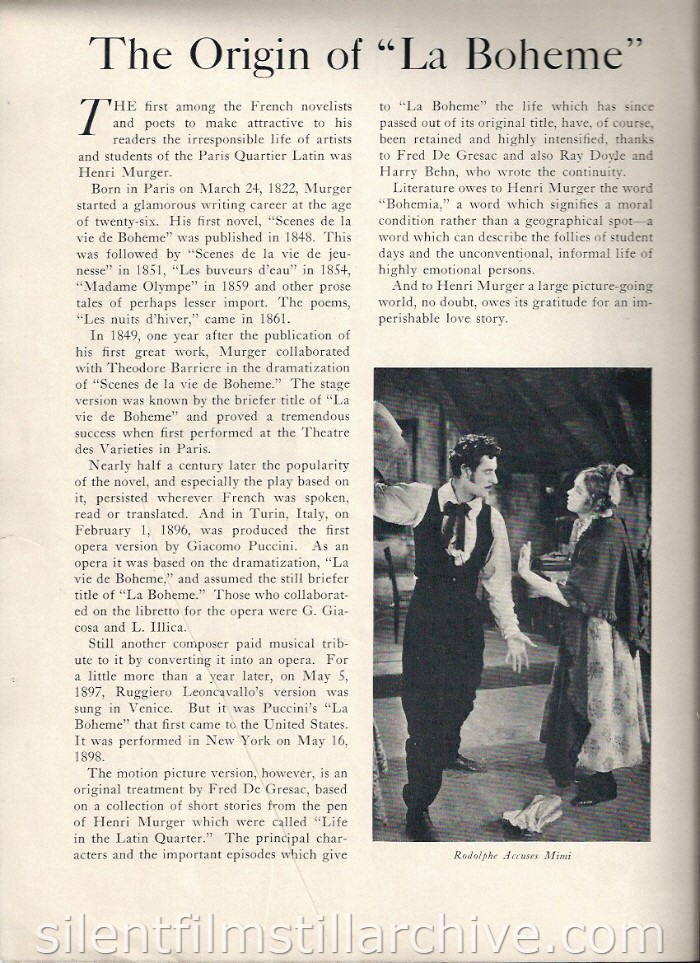
The Origin of "La Boheme"
THE first among the French novelists and poets to make attractive to his readers the irresponsible life of artists and students of the Paris Quartier Latin was Henri Murger.
Born in Paris on March 24, 1822, Murger started a glamorous writing career at the age of twenty-six. His first novel, "Scene de la vie de Boheme" was published in 1848. This was followed by "Scenes de la vie de jeunesse" in 1851, "Les buyeurs d'eau in 1854, "Madame Olympe" in 1859 and other prose tale of perhaps lesser import. The poems, "Les nuits d'hiver," came in 1861.
In 1849, one year after the publication of his first great work, Murger collaborated with Theodore Barriere in the dramatization of "Scenes de la vie de Boheme." The stage version was known by the briefer title of "La vie de Boheme and proved a tremendous success when first performed at the Theatre des Varieties in Paris.
Nearly half a century later the popularity of the novel, and especially the play based on it, persisted wherever French was spoken, read or translated. And in Turin, Italy, on February 1, 1896, was produced the first opera version by Giacomo puccini. As an opera it was based on the dramatization, "La vie de Boheme," and assumed the still briefer title of "La Boheme." Those who collaborated on the libretto for the opera were G. Giacosa and L. Illica.
Still another composer paid musical tribute to it by converting it into an opera. For a little more than a year later, on May 5, 1897, Ruggiero leoncavallo's version was sung in Venice. But it was Puccini's "La Bohee" that first came to the United States. it was performed in New York on May 16, 1898.
The motion picture version, however, is an original treatment by Fred De Gresac, bases on a collection of short stories from the pen of Henri murger which were called "Life in the Latin Quarter." The principal characters and the important episodes which give to"La Boheme the life which has since passed otu of its original title, have, of course, been retained and highly intensified, thanks to Fred De Gresac and also Ray Doyle and harry Behn, who wrote the continuity.
Literature owes to Henri Murger the word "Bohemia," a word which signifies a moral condition rather than a geographical spot -- a word which can describe the follies of student days and the unconventional, informal life of highly emotional persons.
And to Henri Murger a large picture-going world, no doubt, owes its gratiitude for an imperishable love story.
Rodolphe Accuses Mimi
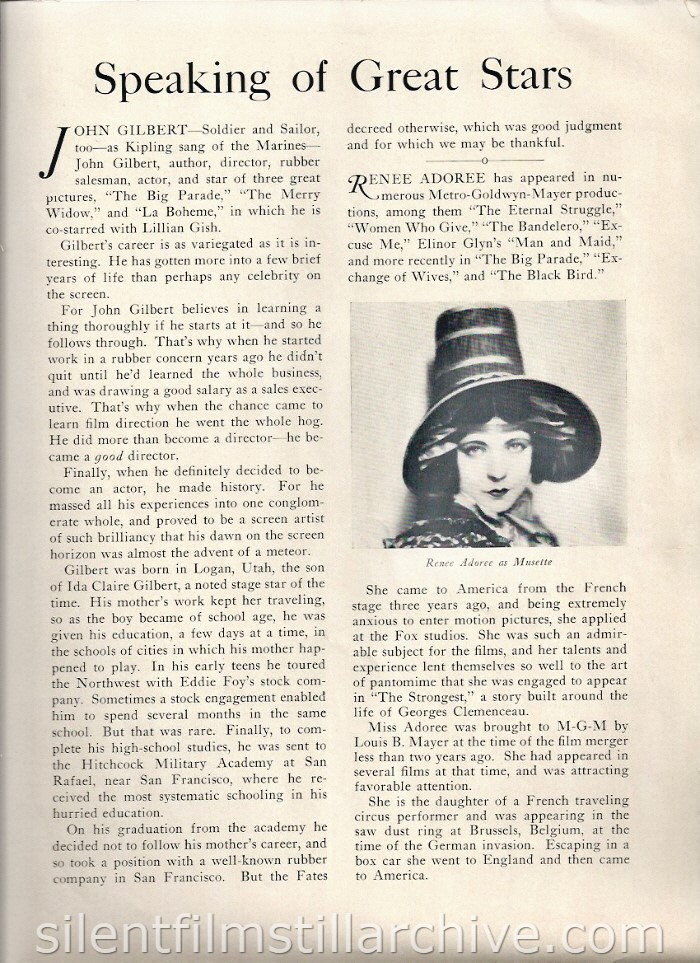
Speaking of Great Stars
JOHN GILBERT -- Soldier and Sailor, too -- as Kipling sand of the Marine -- John Gilbert, author, director, rubber salesman, actor, and star of three great pictures, "The Big Parade," "The Merry Widow," and "La Boheme," in which he is co-starred with Lillian Gish.
Gilbert's career is as variegated as it is interesting. He has gotten more into a few brief years of life than perhaps any celebrity on the screen.
For John Gilbert believes in learning thing thoroughly if he starts at it -- and so he follows through. That's why when he started work in a rubber concern years ago he didn't quit until he'd learned the whole business, and was drawing a good salary as a sales executive. That's why when the chance came to learn film direction he went the whole hog. He did more than become a director -- he became a good director.
Finally, when he definitely decided to become an actor, he made history. For he massed all his experiences into one conglomerate while, and proved to be a screen artist of such brilliancy that his dawn on the screen horizon was almost the advent of a meteor.
Gilbert was born in Logan, Utah, the son of ida Claire Gilbert, a noted stage star of the time. His mother's work kept her traveling, so as the boy became of school age, he was given his education, a few days at a time, in the schools of cities in which his mother happened to play. In his early teens he toured the Northwest with Eddie Foy's stock eompany. Sometimes a stock engagement enabled him to spend several months in the same school. But that was rare. Finally, to complete his high-school studies, he was sent to the hitcock military academy at San Rafael, near San Francisco, where he received the most systematic schooling in his hurried education.
On his graduation from the academy he decided not to follow his mother's career, and so took a position with a well-known robber company in San Francisco. But the Fates decreed othewise, which was good judgment and for which we may be thankful.
RENEE ADOREE has appeared in numerous Metro-Goldwyn-Mayer productions, among them "The Eternal Struggle," "Women Who Give," "The Bandelero," "Excuse Me," Elinor Glyn's "Man and Maid," and more recently in "The Big Parade," "Exchange of Wives" and "The Black Bird."
She came to American from the French stage three years ago, and being extremely anxious to enter motion pictures, she applied at the Fox studios. She was such an admirable subject for the films, and her talents and experience left themselves so well to the art of pantimime that she was engage to appear in "The Strongest," a story built around the life of Georges Clemenceau.
Miss Adoree was brought to M-G-M by Louis B. Mayer at the time of the film merger less than two years ago. She had appeared in several films at that time, and was attracting favorable attention.
She is the daughter of a French traveling circus performer and was appearing in the saw dust ring at Brussels, Belgium at the time of the German invasion. Escaping in a box car she went to England and then came to America.
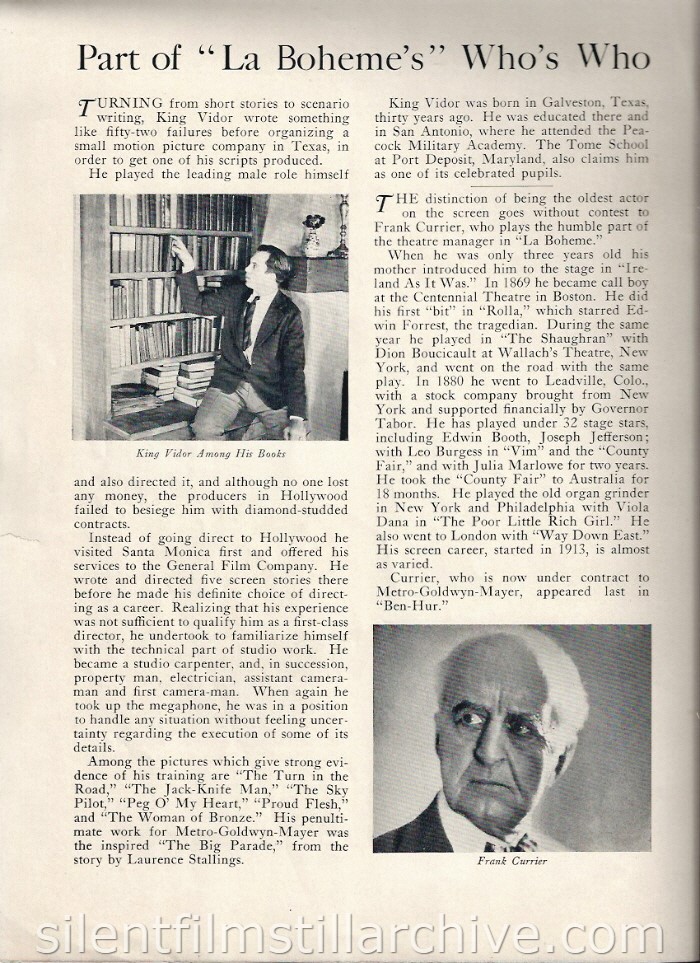
Part of "La Boheme's" Who's Who
TURNING from short stories to scenario writing, King Vidor wrote something like fifty-two failures before organizing a small motion picture company in Texas, in order to get one of his scripts produced.
He played the leading male role himself and also directed it, and although no one lost any money, the producers in Hollywood failed to besiege him with diamond-studded contracts.
Instead of going direct to Hollywood he visited Santa Monica first and offered his services to the General Film Company. He wrote and directed five screen stories there before he made his definite choice of directing as a career. Realizing that his experience was not sufficient to qualify him as a fist-class director, he undertook to familiarize himself with the technical part of studio work. He became a studio carpenter, and, in succession, property man, electrician, assistant camera-man and first camera-man. When again he took up the megaphone, he was in a position to handle any situation without feeling uncertainty regarding the execution of some of its details.
Among the pictures which give strong evidence of his training are "The Turn in the Road," "The Jack-Knife Man," "The Sky Pilot," "Peg O' My Heart," "Proud Flesh," and "The Woman of Bronze." His penultimate work for Metro-Goldwyn-mayer was the inspired "The Big Parade," from the story by Lawrence Stallings.
King Vidor was born in Galveston, Texas, thirty years ago. he was educated there and in San Antonio, where he atteneed the peacock military Academy. The Tome School at Port Deposit, Maryland, also claims him as one of its celebrated pupils.
__________
THE distinction of being the oldest actor on the screen goes without contest to Frank Currier, who plays the humble part of the theatre manager in "La Boheme."
When he was only three years old his mother introduce dhim to the stage in "Ireland As It Was." In 1869 he became call boy at the Centennial Theatre in Boston. he did his first "bit" in "Rolla," which starred Edwin Forrest, the tragedian. During the same year he played in "The Shaughran" with Dion Boucicault at Wallach's Theatre, New York, and went on the road with the same play. In 1880 he went to leadville, Colo., with a stock company brought from New York and supported financially by Governor Tabor. He has played under 32 stage stars, including Edwin Booth, joseph Jefferson; with leo burgess in "Vim" and the "County Fair," and with Julia Marlowe for two years. He took the "County Fair" to Australia for 18 months. He played the old organ grinder in New York and Philadelphia with viola Dana in "The Poor Little Rich Girl." He also went to London with "Way Down East." His screen career, started in 1913, is almost as varied.
Currier, who is now under contract to Metro-Goldwyn-ayer, appeared last in "Ben-Hur."
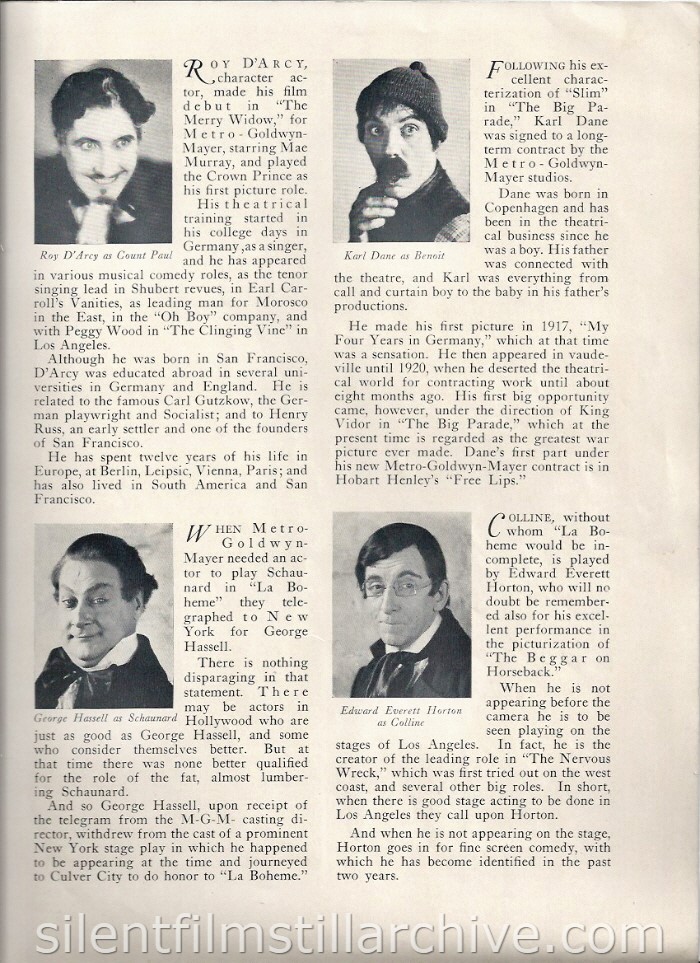
ROY D'ARCY, character actor, made his film debut in "The Merry widow," for Metro-Goldwyn=mayer, starring Mae murray, and played the Crown prince as his first picture role.
His theatrical training started in his college days in Germany, as a singer, and he has appeared in various musical comedy roles, as the tenor singing lead in Shubert reviews, in Earl Carroll's Vanities, as leading man for Morosco in the East, in the "Oh Boy" company, and with Peggy Wood in "The Clinging Vine" in Los Angeles.
Although he was born in San Francisco, D'Arcy was educated abroad in several universities in Germany and England. He is related to the famous Carl Gutzkow, the German playwright and Socialist; and to henry russ, an early settler and one of the founders of San Francisco.
He has spent twelve years of his life in Europe, at Berlin, Leipsic, Vienna, Paris; and has also lived in South America and San Francisco.
WHEN Metro-Goldwyn-Mayer needed an actor to play Schaunard in "La Boheme" they telegraphed to New York for George Hassell.
There is nothing disparaging in that statement. There may be actors in Hollywood who are just as good as George hassell, and some who consider themselves better. But at that time there was none better qualified for the role of the fat, almost lumbering Schaunard.
And so George hassell, upon receipt of the telegram from the M-G-M casting director, withdrew from the cast of a prominent New York stage play in which he happened to be appearing at the time and journeyed to Culver City to do honor to "La Boheme."
FOLLOWING his excellent characterization of "Slim" in "The Big Parade," Karl Dane was signed to a long-term contract by the Metro-Goldwyn-Mayer studios.
Dane was born in Copenhagen and has been in the theatrical business since he was a boy. His father was connected with the theatre, and Karl was everything from call and curtain boy to the baby in his father's productions.
He made his first picture in 1917, "My Four Years in Germany," which at that time was a sensation. He then appeared in vaudeville until 1920, when he deserted the theatrical world for contracting work until about eight months ago. His first big opportunity came, however, under the direction of King Vidor in "The Big Parade," which at the present time is regarded as the greatest war picture ever made. Dane's first part under his new Metro-Goldwyn-Mayer contract is in Hobert Henley's "Free Lips."
COLLINE, without whom "La Boheme" would be incomplete, is played by Edward Everett horton, who will no doubt be remembered also for his excellent performance in the picturization of "The Beggar on Horseback."
When he is not appearing before the camera he is to be seen playing on the stages of Los Angeles. In fact, he is the creator of the leading role in "The Nervous Wreck," which was first tried out on the west coast, and several other big roles. In short, when there is good stage acting to be done in Los Angeles they call upon Horton.
And when he is not appearing on the stage, Horton goes in for fine screen comedy, with which he has become identified in the past two years.
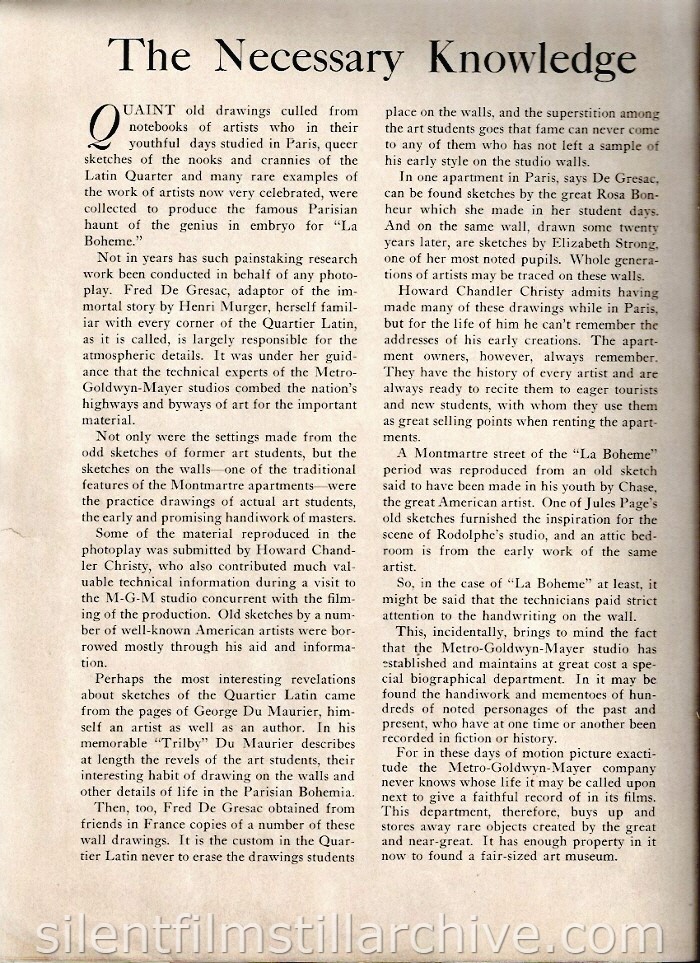
The Necessary Knowledge
QUAINT old drawings culled from notebooks of artists who in their youthful days studied in Paris, queer sketches of the nooks and crannies of the Latin Quarter and many rare examples of the work of artists now very celebrated, were collected to produce the famous Parisian haunt of the genius in embryo for "La Boheme."
Not in years has such painstaking research work been conducted in behalf of any photoplay. Fred De Gresac, adaptor for the immortal story by Henri Murger, herself familiar with every corner of the Quartier Latin, as it is called, is largely responsible for the atmospheric details. it was under her guidance that the technical experts of the Metro-Goldwyn-Mayer studios combed the nation's highways and byways of art for the important material.
Not only were the settings made from the odd sketches of former art students, but the sketches on the walls -- one of the traditional features of the Montmartre apartments -- were the practice drawings of actual art students, the early and promising handiwork of masters.
Some of the material reproduced in the photoplay was submitted Howard Chandler Christy, who also contributed much valuable technical information during a visit to the M-G-M studio concurrent with the filming of the production. Old sketches by a number of well-known American artists were borrowed mostly through his aid and information.
Perhaps the most interesting revelations about sketches of the Quartier Latin came from the pages of George Du Maurier, himself an artist as well as an author. In his memorable "Trilby" Du Maurier describes at length the revels of the art studens, their interesting habit of drawing on the walls and other details of life in the Parisian Bohemia.
Then, too, Fred De Gresac obtained from friends in France copies of a nuber of these wall drawings. It is the custom in the Quartier latin never to erase the drawings students place on the walls, and the superstition among the art students goes that fame can never come to any of them who has not left a sample of his early style on the studio walls.
In one apartment in Paris, says De Gresac, can be found sketches by the great Rosa Bonheur which she made in her student days. And on the same wall, drawn some twenty years later, and sketches by Elizabeth Strong, one of her most noted pupils. Where generations of artists may be traced on these walls.
Howard Changler Christy admits having made many of these drawings while in paris, but for the life of him he can't remember the addresses of his early creations. The apartment owners, however, always remember. They have the history of every artist and are always ready to recite them to eager tourists and new students, with whom they use them as great selling points when renting the apartments.
A Montmartre street of the "La Boheme" period was reproduced from an old sketch said to have been made in his youth by Chase, the great Aerican artist. One of Jules Page's old sketches furnished the inspiration for the scene of Rodolphe's studio, and an attic bedreoom is from the early work of the same artist.
So, in the case of "La Boheme" at least, it might be said that the technicians paid strict attention to the handwriting on the wall.
This, incidentally, brings to mind the fact that the Metro-Goldwyn-Mayer studio has established and maintains at at great cost to a special biographical department. In it may be found the handiwork and mementoes of hundreds of noted personages of the past and present, who have at one time or another been recorded in fiction or history.
For in these days of motion picture exactitude the Metro-Goldwyn-Mayer company never knows whose life it may be called upon next to give a faithful record of in its films. This department, therefore, buys up and store away rare objects created by the great and near-great. It has enough property in it now to found a fair-sized art museum.
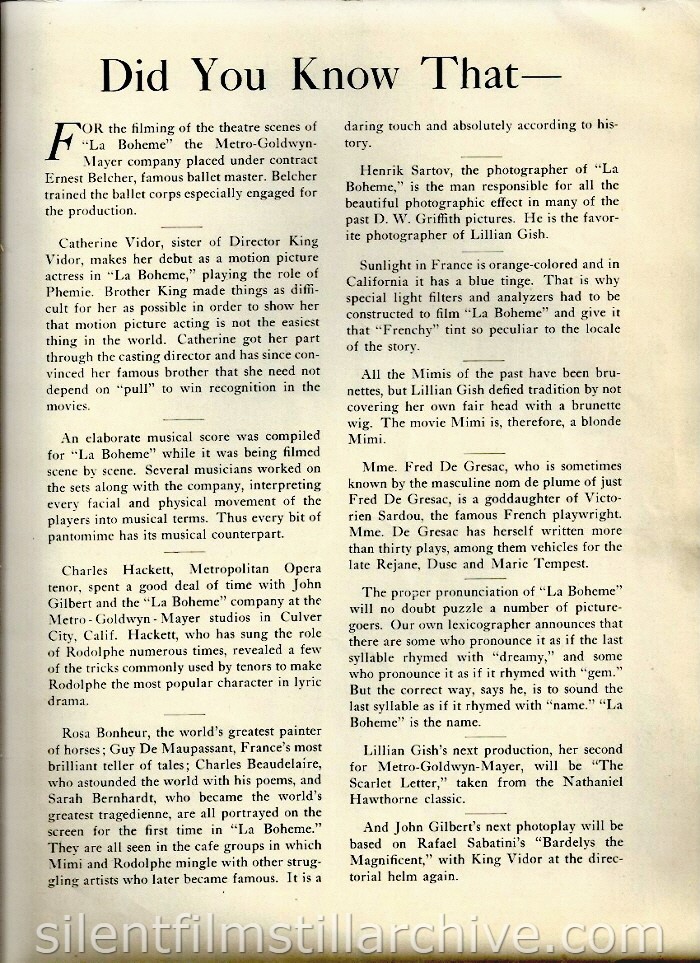
Did You Know That --
FOR the filming of the theatre scenes of "La Boheme" the Metro-Goldwyn-Mayer company placed under contract Ernets Belcher, famous ballet master. Belcher trained the ballet corps especially engaged for the production.
Catherine Vidor, sister of Director King Vidor, makes her debut as a motion picture actress in "La Boheme, playing the role of Phemie. Brother King made things as difficult for her as possible in order to show her that motion picture acting is not the easiest thing in the world. Catherine got her part through the casting director and has since convinced her famous brother that she need not depend on "pull" to win recognition in the movies.
An elaborate musical score was compiled for "La Boheme" while it was being filmed scene by scene. Several musicians worked on the sets along with the company, interpreting every facial and physical movement of the players into musical terms. Thus every bit of pantomime has its musical counterpart.
Charles hackett, Metropolitan Opera tenor, spent a good deal of time with John Gilbert and the "La Boheme" company at the Metro-Goldwyn-Mayer studios inCulver city, Calif. Hackett, who has sung the role of Rudolphe numerous times, revealed a few of the tricks commonly used by tenors to make Rodolphe the most popular character in lyric drama.
Rosa Bonheur, the world's freatest painter of horses; Guy De Maupassant, France's most brilliant teller of tales; Charles Beaudelaire, who astounded the world with his poems, and Sarah Bernhardt, who became the world's greatest tregedienne, are all portrayed on the screen for the first time in "La Boheme." There are all seen in the cafe groups in which Mimi and Rodolphe mingle with other struggling artists who later became famous. It is a daring rouch and absolutely according to history.
Henrik Sartov, the photographer of "La Boheme," is the man responsible for all the beautiful photographic effect (sic) in many of the past D. W. Griffith pictures. He is the favorite photographer of Lillian Gish.
Sunlight in France is orange-colored and in California it has a blue tinge. That is why special light filters and analyzers had to be constructed to film "La Boheme" and give it that "Frenchy" tint so peculiar to the locale of the story.
All the Mimis of the past have been brunettes, but Lillian gish defied tradition by not covering her own fair head with a brunette wig. The movie Mimi is, therefore, a blonde Mimi.
Mme. Fred De Gresac, who is sometimes known by the masculine nom do plume of just Fred De Gresac has herself written more than thirty plays, among them vehicles for the late Rejane, Duse and marie Tempest.
The proper pronunciation of "La Boheme" will no doubt puzzle a number of picture-goers. Our own lexicographer announces that there are some who pronounce it as if the last syllable rhymed with "dreamy," and some who pronounce it as if it rhymed with "gem." But the correct way, says he, is to sound the last syllable as if it rhymed with "name." "La Boheme" is the name.
Lillian Gish's next production, her second for Metro-Goldwyn-Mayer, will be "The Scarlet Letter," taken from the Nathaniel Hawthorne classic.
And John Gilbert's next photoplay will be based on Rafael Sabatini's "Bardleys the Magnificent," with King Vidor at the directorial helm again.

TED HENKEL
Musical Director
FORUM THEATRE
A Metro-Goldwyn-Mayer PICTURE
This book sold only in theatres showing "La Boheme." It may be purchased in quantity from AL GREENSTONE, 1547 Broadway, N.Y.
with Lillian Gish, John Gilbert and Renée Adorée. Directed by King Vidor. Metro-Goldwyn-Mayer.
More Information on the Forum Theatre...
The Forum Theatre at CinemaTreasures.com
More Information on this film...

This work (La Bohème (1926), by
M-G-M),
identified by
Bruce Calvert, is free of known copyright
restrictions.
Books
(none)
Last Modified April 30, 2016



















